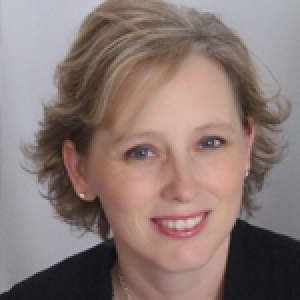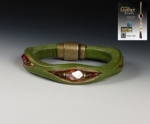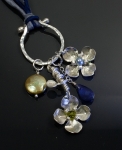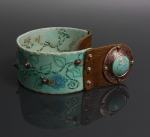- NEW DVD Series – Stone Setting with Bezels
- Tube Set Charm by Kim St. Jean
- Prong Basket Pendant by Kim St. Jean
- NEW DVD Series – Stone Setting with Cold Connections
- New DVD Series – Stone Setting with Wire
- NEW DVD Series: Introduction to Stone Setting by Kim St. Jean
- Featured Tool: Bracelet Bending Plier
- NEW Dvd by Eva Sherman
- Fun, Fast Fold Forming DVD Series
- Double Band Ear Cuff from Alex Simkin
Create Recklessly
Create Recklessly; an interview with Melissa Cable
Melissa Cable is a mixed media jewelry artist, instructor and author who thrives on developing new designs and techniques with traditional and non-traditional materials, from metal, leather, and plastics to wood, clay and found objects. She is fascinated by the translation of techniques between materials and shares this love with students in her workshops around the world.
Melissa enjoys documenting her experiments on her blog, Create Recklessly. She is the author of Spotlight on Wire (2011), Metal Jewelry in Bloom (2013) and Beautiful Leather Jewelry (2014) and her work has been featured in Art Jewelry, BeadStyle, Stringing Magazine, Wirework Magazine, Step-by-Step Wire and Showcase 500 Art Necklaces. In addition to creating her own products under her Create Recklessly brand, Melissa serves as a consulting design for Faux Bone and is on the design team for Patrik Kusek’s Woodland Chic. She resides in the Greater Seattle area, where she calls Fusion Beads her teaching home. When she is not chasing after her young daughter and son, she might be found writing, running or rambling.
(audio not playing? click here)
Explore Melissa’s Classes this February in Tucson:
|
Feb.2, 10:30am – 2:00pm |
Feb.4, 10:30am – 2:00pm |
Feb.5, 10:30am- 2:00pm |
Transcript of our interview with Melissa Cable
Heather: We are on the phone with Melissa Cable. How are you Melissa?
Melissa: Good, how are you doing?
Heather: Doing well thank you. She is going to be teaching with us for her first year at the JOGS show in Tucson. Thank you for taking a moment out of your day to talk with us. Let’s start off by telling everyone which medium you primarily work in and what was your process of experimenting and discovery?
Melissa: I think sometimes the question is really what medium I don’t work in. I’m inspired by materials and the best way I can explain my work is that I’m fascinated by the translation of techniques between materials. So how will something that works on metal work on leather and how will something that works on leather work on faux bone which is a pvc product, how will that work on wood? How will that work on ceramic? And so I’m really playing with techniques between a lot of mediums on any given day.
Heather: Wow. So what are some of the tools you use most often?
Melissa: I can’t live without my rubber bench block. One of the most inexpensive tools in my studio is this black rubber bench block. I love it. I use it to anchor my pieces when filing, in a pinch I use it as a thing to put my material on when I’m drilling, and a good pair of metal sheers. I have this fabulous little mini vise that I love to hold on to things and of course my flex shaft. I can’t live without it and I have an extra hand piece for it now and that’s really been able to change the way I work. I can kind of leave my common bits in there and just change out the head one when I’m working
Heather: Wonderful. So have you ever improvised a tool or repurposed a tool?
Melissa: Oh gosh, all the time. And because I work with faux bone, it’s a PVC product that you can heat form at about 240 degrees but it doesn’t outgas until 290. I make tools with faux bone all the time in a pinch when I need something. One of my favorites is that I like to make copper frames out of washers where the inside flares out to hold a cabochon or any other item you want to capture and when I do that in a traditional dapping block I’ve found that the copper washer, the entire thing would dome and it really doesn’t allow it to lay flat and it makes it difficult to rivet without having those puckers around the rivet and so I was able to make the tool with two faux bone washers, kind of hard to explain but basically I sandwiched the copper washer in between two faux bone donuts and I can dap straight down the middle of those donuts flaring the copper frame but leaving the edges flat because they’re captured between the faux bone. I use that tool all the time. I’ve been using it with leather as well to create flared leather frames. I love to make tools.
Heather: That’s awesome. What’s your favorite way to finish a piece or your favorite effect?
Melissa: This is a little simple trick that I came up with when I owned a bead shop years and years ago and it just sounds silly but it really looks beautiful. It’s just a little hand held battery operated bead reamer, and if you stick a diamond bur tip (kind of like the flame shape or bullet shape) and go over the surface of the metal in circular motion on the side of that diamond bur, it creates an effect and it’s a really pretty finish on metal and it’s easy for when I travel for students to do. It’s just hand operated but it really puts a professional finish on their metal really easily.
Heather: What advice would you give a beginner who is maybe intimidated by how intricate the process seems?
Melissa: Oh gosh and that happens a lot. I remember when I’d learn new things. I would sit down and make it once and then when I want to make it again it’s so overwhelming mostly because I’m thinking about all the stuff I have to gather in order to do this new technique, so what I’ve been suggesting to students for many years now is when they start something new, take a picture of your workspace as they begin because our minds work in such a great way. We are very visual creatures so if we can just pull that picture out and see “ok I need this tool this tool this tool” it doesn’t seem so overwhelming. You aren’t running through this catalog in your mind, you have a visual representation of what it is you need to get going on that project. If you just pull it out of the drawer whenever you go back to working on that particular type of project, just pull it out and know what you have to pull to get going.
Heather: That is some great advice, for sure. Once you make a piece you are happy with, where does it go?
Melissa: People ask me that all the time and I’m so embarrassed by the answer, but sadly my most favorite pieces slowly get destroyed because they excite me so I end up turning them into classes. I really want to share it with other people. They become class samples and they travel all over with me and I’ll be the first to admit that I don’t honor them and pack them as well as they should be. But they definitely get their test for durability that’s for sure! They end up as class samples mostly. I have drawers and bins of everything that I’ve made. I always keep the first one that I make so I have accumulated over the years.
Heather: I can only imagine. What gives you inspiration to try new things, or what keeps you motivated?
Melissa: Well my motto and my blog is “Create Recklessly” and that’s really how I work. I have no thought to what the end product is going to look like generally when I start something. I just get in there and go “Hey will this work? Will this work?” How will this combine and try new skills I’ve learned in other mediums and again translate it to whatever I’m working on at that point. I think by having that need to create recklessly it keeps me excited because I never know what’s going to happen. I never know what the outcome is going to be. It’s like a game almost or a good movie, waiting to see what the end is going to prove to be so that is what really keeps me motivated.
Heather: So you’ve been making and teaching jewelry for several years now, what have you noticed about your work that has evolved?
Melissa: I think how I use my tools. I literally have to attribute that to a few people. I’ve been lucky to take some really great classes from amazing artists over the years and both Robert Dancik and Andy Cooperman have really made me look at my tools in a different way. You pick up something and it’s a hammer and therefore you know you hammer with it. Well Robert Dancik said “hey in a pinch turn that thing over and now you have a little anvil if you need it.” Things like that I didn’t think about. I really worked hard to open my mind to look at my tools in a whole different way.
Heather: Great. What’s something you’ve learned from a student of yours?
Melissa: One of my favorite tricks was from a gentleman named Fleming. I was teaching a workshop in Switzerland and he didn’t speak any English and I didn’t speak his language. We really could only communicate by showing each other things. He showed me how to take a piece of faux bone and put it in your flex shaft and use a file on it and you can turn a little disc bead using your flex shaft. I never thought to put material in the flex shaft. It’s a great trick and again it’s kind of opened my mind to constantly think about not just putting bits and burs in my flex shaft but putting materials when it is appropriate which is something Andy Cooperman is known for teaching people. It’s really fun that Fleming reinforced that and showed me a great way to make these beads. I documented it on my blog “Create Recklessly” so that people can create these beads themselves.
Heather: That sounds very interesting. Why do you think people love to wear jewelry and why do you think people love to make jewelry?
Melissa: Well I think jewelry is the ultimate in personal expression. We all express ourselves in different ways from the clothes we wear to anything we adorn ourselves with. Jewelry is that great way to change it every day. One day you might be wearing that big statement piece and it says something about how you feel or where you want to go and the next day maybe something sentimental; showing something that’s important to you like something that your daughter made. The macaroni necklace that all of us as moms have had to wear at least once to the grocery store is a good example. I think the reason people like to make jewelry is that it is the ultimate in self expression. The best way I’ve ever heard it explained is my mentor Robert Dancik said that the things he wants his students to realize is that when you sit down and make a piece of jewelry, that object in history is forever. It never existed until that moment, the moment you created it. You’ve added something to your own life and to the life of others and to the world. It really is a bigger thing when you sit and think about that and I love that thought that we are creating objects that never existed before.
Heather: That’s beautiful. Well that concluded my questions today. Thanks so much for taking time to give some of our listeners a little in depth knowledge about you. Everybody come take a class from Melissa at the JOGS show! Thanks Melissa!
Melissa: bye bye!
Don’t Miss Melissa in Tucson!
|
Feb.2, 10:30am – 2:00pm |
Feb.4, 10:30am – 2:00pm |
Feb.5, 10:30am- 2:00pm |

























0 comments